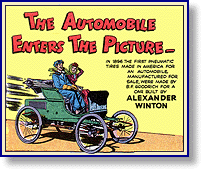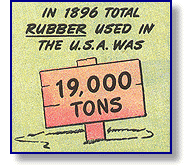
Our rubber expedition is heading now to Ireland, and the year is 1888. We're in the city of
Belfast, in what will someday become Northern Ireland. 1888 was a good time to be a
veterinarian. Horses, donkey, mules and oxen pull wagons and plows. No one could get much
done without them. However, this will soon change when new fangled automobiles and farm
tractors put the horses out to pasture.
A Smoother Ride
It is a veterinarian who makes all of this possible, wouldn't you know, a vet named
John Boyd Dunlop. Dunlop was born in Scotland but lives in Belfast.
In 1888, Dunlop is experiencing the joys of parenthood. Dunlop has a son who rides
a tricycle, just like many kids. But the ride was rough, seeing as the tricycle's wheels are
treaded with bare metal. So Dunlop has come up with an idea to
smooth out the youngster's ride. He has made a set of tires for the tricycle. He took two
strips of rubber, and glued the edges together to make a tube. He wrapped the tube around
the tricycle wheel, and wrapped the tube in linen tape to give the tire a tread. Then he did
something which was unusual for the time. He filled the rubber tube with air using a pump
made for filling soccer balls.
Dunlop's tires are pneumatic, that is they were inflatable. Until then most tires were
made out of solid rubber. But pneumatic tires gives a much smoother ride.
He isn't the first to do this. Another Scottish inventor named Robert Thompson had invented an
inflatable tire back in 1845, but no one paid much attention to it. So it was left to Dunlop to
reinvent the pneumatic tire forty-three years later.

|
Cartoon of the first pneumatic tires
made commercially in the U.S.
|
A Bigger Market Than Tricycles
It won't be long before carriages and then the new automobiles start using Dunlop's tires.
In fact, practical automobiles wouldn't be possible without Dunlop's inflatable tires.
Dunlop's company will grow and grow, not surprisingly, since everyone will want a car, and
all cars need tires. At first tires are made by hand, with much difficulty, a process to make
tires by machine will eventually speed things up. (Click
here to see the process illustrated in full
color!) Now that tires are in demand, a lot of rubber is going to be needed. To make sure they
would always have a good supply of rubber, the Dunlop Rubber Company eventually begin buying up
rubber plantations in the British colonies in southeast Asia.
 Dunlop's tires are made of polyisoprene, natural rubber.
But natural rubber has a big problem. Have you ever blown up a balloon,
and then noticed how it slowly will get smaller
as the days pass? This is because air can pass through natural rubber. It happens slowly,
but it does happen. Eventually the air will leak out of the balloon, and it will deflate.
Inner tubes made from natural rubber will suffer from the same problem, at least until the
invention of a gas-impermeable synthetic rubber called butyl rubber. But that is still
some years away.
Dunlop's tires are made of polyisoprene, natural rubber.
But natural rubber has a big problem. Have you ever blown up a balloon,
and then noticed how it slowly will get smaller
as the days pass? This is because air can pass through natural rubber. It happens slowly,
but it does happen. Eventually the air will leak out of the balloon, and it will deflate.
Inner tubes made from natural rubber will suffer from the same problem, at least until the
invention of a gas-impermeable synthetic rubber called butyl rubber. But that is still
some years away.
Ominous Clouds over the Pacific
Dunlop's company will develop more interests in Asia. Let's jump ahead in time to the year
1913. In this year, Dunlop is opening a tire factory in Kobe,
Japan. This is Japan's first tire factory, and by no means the last. Japan is developing
a huge appetite for rubber. Japanese life was becoming more industrialized, and dependent on
rubber...just like life in a lot of the rest of the world. One industry in particular is going
to need a lot of rubber, and its leaders know just how to get it.
Meanwhile...
While Dunlop was putting tires on his son's tricycle, this is going on in the rest of the world.
1886: In New York City the Statue of Liberty is completed.
1888: In Germany, radio waves are discovered by Heinrich Hertz.
1890: In Japan, the Diet meets for the first time. It is the country's first parliament.
Bibliography
Image credits
Cartoon of the first pneumatic tires made commercially in the U.S.: From Wonder Book
of Rubber, 1947, copyrighted material of The BFGoodrich Company reproduced with the
permission of The BFGoodrich Company.
In 1896, total rubber used...: From Wonder Book
of Rubber, 1947, copyrighted material of The BFGoodrich Company reproduced with the
permission of The BFGoodrich Company.
Destination Northern Ireland:

Destination Northern Ireland:

 Dunlop's tires are made of polyisoprene, natural rubber.
But natural rubber has a big problem. Have you ever blown up a balloon,
and then noticed how it slowly will get smaller
as the days pass? This is because air can pass through natural rubber. It happens slowly,
but it does happen. Eventually the air will leak out of the balloon, and it will deflate.
Inner tubes made from natural rubber will suffer from the same problem, at least until the
invention of a gas-impermeable synthetic rubber called butyl rubber. But that is still
some years away.
Dunlop's tires are made of polyisoprene, natural rubber.
But natural rubber has a big problem. Have you ever blown up a balloon,
and then noticed how it slowly will get smaller
as the days pass? This is because air can pass through natural rubber. It happens slowly,
but it does happen. Eventually the air will leak out of the balloon, and it will deflate.
Inner tubes made from natural rubber will suffer from the same problem, at least until the
invention of a gas-impermeable synthetic rubber called butyl rubber. But that is still
some years away.